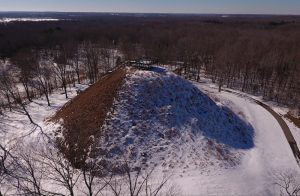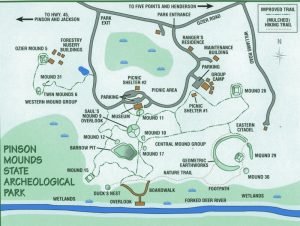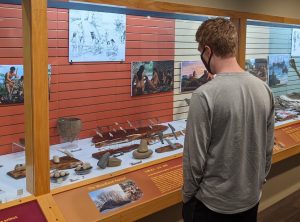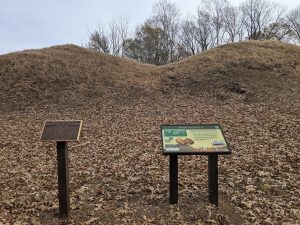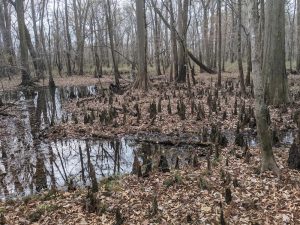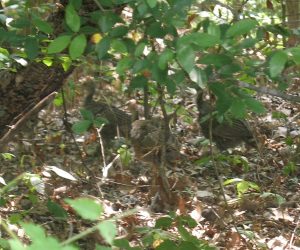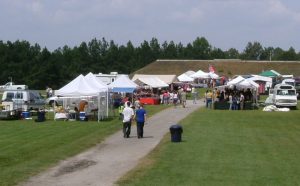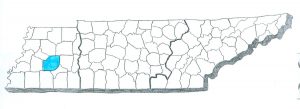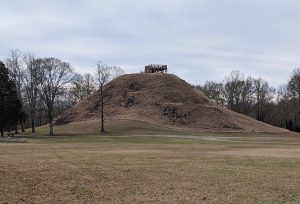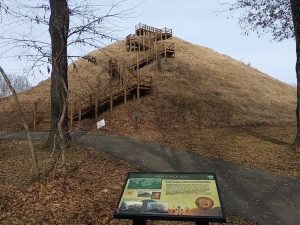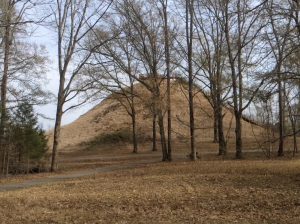For several hundred years, maybe about 200 BC until about 750 A.D., what is believed to have been the tallest man-made object in the land we now call the United States?
Answer: Saul’s Mound, at the Pinson Mounds State Archaeological Park.
Pinson Mounds is in Madison County, about eight miles south of Jackson. Today it is an out-of-the-way place. But there is every reason to believe that at one time this was one of the most important places in North America. We’re going to show you around. But first we need to give you some background.
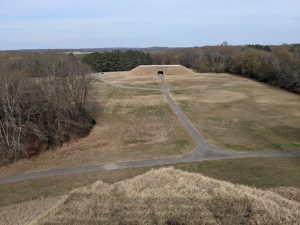
From the top of Saul’s Mound you can see the state park visitor’s center, which looks like a mound as well!
“Prehistoric” refers to things that took place before the people and societies referred to had a written language. Pinson Mounds contains the remains of a Native American community that existed in prehistoric time and was abandoned long before European settlers arrived in Tennessee.
People have discovered the remains of Native American mound communities all over Tennessee. Most of these mounds have been destroyed over the years, cleared by farmers or by people building highways or new buildings. Pinson Mounds, on the other hand, is protected under government ownership (as are other mound complexes such as the Sellars Farm in Wilson County and at Harpeth River in Cheatham County).
The thing that has to be emphasized about Pinson Mounds is its size. Compared to places like Sellars Farm and Harpeth River, Pinson is huge. The complex covers 500 acres, and there are known to be at least 17 man-made mounds here. Among them are Saul’s Mound (which is 72 feet high), Ozier Mound (33 feet high) and many others that you can see from a distance.
Pinson Mounds was occupied during the Woodland Era, which went from around 1000 BC until about 1000 AD. During the Woodland Era, permanent towns were formed, people began making pottery out of clay, and agriculture became common. Based on things that have been found at the site, activity at Pinson Mounds appears to have taken place between 200 BC and 500 AD. This is the same period in which Old Stone Fort was active. (By the way, you can learn a lot about different prehistoric eras and about archaeology at the Pinson Mounds museum.)
The mounds here were built by hand, one basketful of dirt at a time, but we don’t know how many people were involved in building them or how long it took. However, we do know that some of them were built in stages.
Evidence seems to indicate that, at first, Pinson was mainly a residential community, where people lived. But as the years went by it evolved into more of a ceremonial and religious place, which people visited but didn’t live permanently.
The people who built Pinson Mounds appear to have been somewhat knowledgeable about astronomy (the study and movement of the sun, moon and stars). If you stand on top of Saul’s Mound on the Spring Equinox (March 21) and the Fall Equinox (September 21) and watch the sunrise, you will notice that it rises directly behind Mound 29.
Many archaeologists believe that this is not a coincidence; after all, other mounds sites in the world from this time period are arranged with astronomy in mind. One common theory is that ceremonies occurred during Spring Equinox (related to planting) and Fall Equinox (related to harvesting).
On the western side of the Pinson Mounds complex you will find a group of mounds known as Ozier Mound, the Twin Mounds and Mound 31. Previous digs in this area have shown that there were human burials and cremations on these mounds.
In 1983, for instance, archaeologists discovered a single tomb with the bodies of eight young women in it. All were wearing headdresses decorated with copper ornaments and some wore fresh water pearls with Marginella shells. In an adjacent tomb, four older men were found buried together. We don’t know why these people were buried together, or why the women were buried with exotic jewelry, but some have theorized that these people were elite. The bodies were covered up after being discovered, and there have not been any digs on the Twin Mounds in recent decades.
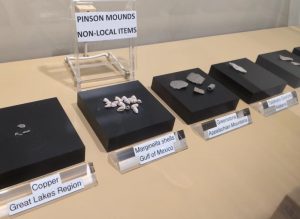
The museum has samples of the types of items that they have found in the ground at Pinson Mounds that came from very far away.
By the way, the discovery of copper ornaments and shells tells us something else about Pinson Mounds. The copper apparently came from the Great Lakes region; the shells from the Gulf of Mexico. So the very existence of these items tells us that there were extensive trade routes during the Woodland Era.
Archaeologists still have a lot to learn about Pinson Mounds. Only a few years ago an archaeologist named Mark Norton discovered a mound in the middle of the pine tree orchard that is part of the complex; it had apparently been eroded and worn down by extensive farming. In the summer of 1999 a team of archaeologists from Middle Tennessee State University conducted a dig on the site, now known as Mound 37.
Finally, here are six tips about visiting Pinson Mounds State Archaeology Park:
* The 20-minute film at the visitors center is definitely worth seeing, and tells you a lot about the story behind the mounds.
* The park is very flat, and there is a network of paved trails that goes just about everywhere. Therefore, this is a great place to bring your bike!
* Next to the main mound complex is a nature trail and a wooden boardwalk that takes you through some wonderful swamp areas dominated by cypress trees. If you take the boardwalk, you will get a nice view of the Forked Deer River, or at least the course that the river now takes. But this is not the original course of the river. It was “channelized,” or straightened, several years ago.
* There’s a lot of wildlife at Pinson Mounds. On one of our visits we spotted deer, a black snake, wild turkey and many mosquitoes. Keep your eyes open. And bring insect repellant, keeping in mind that chiggers attack your ankles, regardless of whether you have socks and shoes on or not.
* A good time to visit Pinson Mounds is when the state park is having some sort of an event. The best time to see the mounds themselves is during the winter. That’s when the leaves aren’t on the trees and you can see the mounds best.
Thanks to Aaron Deter-Wolf for his assistance in the creation of this virtual tour.
